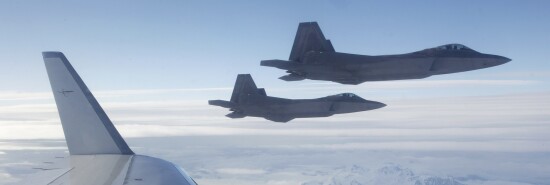
China, or the problem with F-22 fighter jets leaving Okinawa but arriving in Poland
Tom Rogan
While the United States faces many national security challenges, it has limited military resources. It’s disingenuous to claim that resolving this imbalance can be accomplished with defense budget boosts that have no chance of becoming law. At the pinnacle of security statecraft, the maximal countering of China’s threats to Taiwan cannot coexist with a maximal countering of Russian threats to Eastern Europe. This doesn’t mean abandoning America’s best NATO allies, nor should it ever. Still, tough choices must be made on where to deploy finite military capabilities.
We just gained a key reminder of this necessity with regards to two different deployments of U.S. Air Force F-22 fighter jets. The F-22 is the world’s finest air superiority fighter: stealthy, maneuverable, and heavily armed.
MR. MACRON, THE MODERN TALLEYRAND, GOES TO BEIJING
Last week, F-22 fighter jets from the Virginia-based 94th Fighter Squadron began arriving at Powidz air base in central-western Poland. That squadron is replacing an Air Force F-15E fighter squadron normally based out of England. Their mission is important: defending NATO’s eastern flank, especially the vulnerable Baltic States that border Russia. NATO says that the F-22s will also operate over the Black Sea. Hopefully, that means they’ll be used to escort reconnaissance flights over the Black Sea. It was only last month that Russia downed a U.S. drone that was flying in international airspace over those waters.
Still, this F-22 deployment is only one side of the rotation of forces coin. Also last week, F-22s from the Alaska-based 525th fighter squadron returned home after a deployment to Okinawa. Those F-22s have now been replaced in Okinawa by an F-15E fighter jet squadron based out of North Carolina.
Why the replacement of F-22s with F-15s and vice versa?
Because the Air Force only has about 110-140 F-22s operationally ready at any one time. It can’t keep F-22s forward deployed everywhere, all the time. Yet, by sending F-22s out of the Pacific and into Europe, the Pentagon weakens its already vulnerable posture in the Pacific. And it’s not the first time this has happened. Another F-22 squadron assigned to the Pacific air forces was sent to Poland last July.
The problem is that F-22s would be critical to any successful U.S. campaign to defend Taiwan against China. The People’s Liberation Army would have major numerical, geographic, and force disposition advantages in any war with the U.S. over Taiwan (though recent developments with the Philippines offer a ray of hope). And while the U.S. still has F-35 stealth fighter jets based out of Okinawa, those aircraft — contrary to the arguments of some — lack the range and weapons payloads needed for the Taiwan fight (the F-15EX is a far better alternative here).
Top line: Addressing China’s threat to Taiwan requires the U.S. to maximize the scaled readiness of its best warships (another issue with regards to stretched resources) and aircraft in the Pacific. U.S. nuclear weapons and Army maneuver forces should be kept on NATO’s eastern flank, but NATO air forces should fill the F-22 gap. Indeed, unlike in the Pacific, the F-35, which many NATO nations now possess, is well suited to fighting Russian air and air defense forces. The F-22s, however, need either to be going to the Pacific or undergoing maintenance at their home bases. Spreading these forces thin, the U.S. undermines an already weakened means of defending Taiwan.
The U.S. cannot do everything everywhere. Pretending otherwise is to embrace arrogant strategic idiocy.
